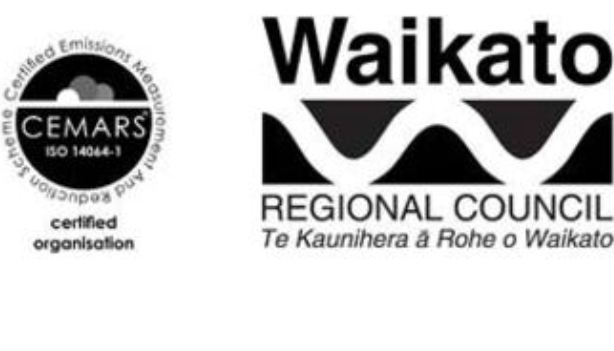Waikato Regional Council is doing its bit to support New Zealand’s move to a low carbon economy by publicly committing to reduce its carbon footprint and work with others to plan for the introduction of climate change legislation.
The council is a Certified Emissions Measurement and Reduction Scheme (CEMARS) organisation – the first regional council, and one of only five councils in New Zealand, to receive certification.
To achieve certification, the council measured all operational emissions, including travel, fuel use, electricity consumption and waste during 2016/17. Emissions will continue to be measured annually and the council has developed a plan to achieve three-yearly targets to reduce emissions.
Council chief executive Vaughan Payne said CEMARS certification provided the council with an internationally-recognised programme of advice, best practice, applied science and tools to help manage and measure greenhouse gas emissions.
“We’ve worked hard in recent years to measure our carbon footprint and this information has enabled us to start making informed choices about the actions we need to take to reduce our emissions as an organisation,” he said.
“Reducing our carbon footprint comes with extra benefits – it delivers cost savings and is important to our staff and communities who expect us to do the right thing when it comes to our environment, the economy and community wellbeing.”
In addition to its internal organisational activities, the council is also developing a Waikato Regional Climate Change Response Roadmap that will help inform community discussions about the issues and opportunities that a low emissions future will bring.
“Waikato people are particularly tuned in to the impacts of climate change, having to deal with river and coastal flooding and droughts and they have a significant stake in any proposed climate change legislation.”
The Government has started consulting the public on it Zero Carbon Bill, with meetings planned in Hamilton for Thursday [June 14]. The Bill proposes net zero emissions by 2050.
Precisely what kind of emissions New Zealand would be pushing down to net zero, and how, is still up for discussion. The term “net” emissions is normally used to describe gross emissions minus the emissions removed from the atmosphere through the impact of land use and forestry.
The Waikato climate change roadmap will include opportunities for reducing greenhouse gas emissions, many of which focus on land use changes that will also help improve water quality.
“In 2016 we completed a stocktake to understand greenhouse gas emissions in the region and this work shows our region is changing,” Mr Payne said.
In 2002, despite being 10 per cent of the nation’s land area and 12 per cent of its population, the Waikato region was responsible for 21 per cent of the nation’s gross greenhouse emissions.
However, the 2016 stocktake shows activities within the Waikato generated 13.8 million tonnes of carbondioxide equivalent (tonnes CO2e). When forestry is included, the total net emissions are reduced to 8.2 million tonnes CO2e.
This means our region’s contribution to gross national emissions in 2016 was 17.2 per cent. Over the period from 2002, national emissions increased at the same time electricity generation from Huntly moved increasingly to gas, which has lower emissions than coal.
Read more at www.waikatoregion.govt.nz/our-performance.
